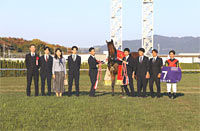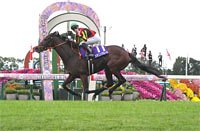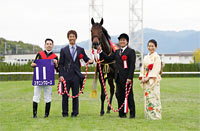Queen Elizabeth II Cup (G1) - Data Analysis
Filly or mare champion decider of the autumn season that has seen notable performances by dark horses over the years
In the 2022 Queen Elizabeth II Cup, Geraldina triumphed backed by win odds of 8.1 (4th favorite), while Win Marilyn and Lilac tied for 2nd backed by win odds of 10.1 (5th favorite) and 52.9 (12th favorite), respectively, resulting in a Trio payout of over 90,000 yen, and two types of Trifecta payouts that both exceeded 200,000 yen. In the 2021 race, Akai Ito secured the victory backed by win odds of 64.9 (10th favorite), Stellaria finished 2nd backed by win odds of 25.1 (7th favorite), and Clavel came in 3rd backed by win odds of 46.9 (9th favorite), resulting in a Trio payout of 282,710 yen and a substantial Trifecta payout of 3,393,960 yen. If trends in recent years are anything to go by, we should assume this race offers ample potential for an upset. Let's now analyze some features shared by successful runners in this race based on results over the last 10 years, including the years from 2020 to 2022, when the race was held at Hanshin Racecourse.
Watch grade of previous race
Of the 30 Top 3 finishers over the last 10 years, 28 had contested a G1 or G2 race in their previous race. Conversely, runners that had contested a race other than a G1 or G2 race struggled with a Top 3 ratio of 3.7%. We should therefore lower our expectations of runners with such profiles. [Table 1]
[Table 1] Performance by previous race (last 10 years)
| Previous race |
Performance
[1st-2nd-3rd-4th or lower] |
Win ratio |
Top 2 ratio |
Top 3 ratio |
| G1, G2 race |
10-10-8-93 |
8.3% |
16.5% |
23.1% |
| Other race |
0-1-1-52 |
0% |
1.9% |
3.7% |
Note: Two runners tied for 2nd in 2022.
Poor showing by runners coming straight from a major defeat
Of the 30 Top 3 finishers over the last 10 years, 29 had finished 7th or higher in their previous race. Meanwhile, runners that had finished 8th or lower struggled with a Top 3 ratio of 2.6%. This suggests runners that were beaten to 8th or lower in their most recent race, are unlikely to chase the top places. [Table 2]
[Table 2] Performance by finish in previous race (last 10 years)
Finish in
previous race |
Performance
[1st-2nd-3rd-4th or lower] |
Win ratio |
Top 2 ratio |
Top 3 ratio |
| 7th or higher |
10-10-9-108 |
7.3% |
14.6% |
21.2% |
| 8th or lower |
0-1-0-37 |
0% |
2.6% |
2.6% |
Note: Two runners tied for 2nd in 2022.
Focus on horses aged 4 or below
Of the 30 Top 3 finishers over the last 10 years, 24 were horses aged 4 or below. Conversely, horses aged 5 or above struggled with a Top 3 ratio of 7.8%. In other words, we should focus on younger horses. [Table 3]
[Table 3] Performance by age (last 10 years)
| Age |
Performance
[1st-2nd-3rd-4th or lower] |
Win ratio |
Top 2 ratio |
Top 3 ratio |
| 4 or below |
9-7-8-74 |
9.2% |
16.3% |
24.5% |
| 5 or above |
1-4-1-71 |
1.3% |
6.5% |
7.8% |
Note: Two runners tied for 2nd in 2022
In addition, four of the six runners that finished in the Top 3 despite being aged 5 and above, had experience of finishing in the Top 7 of a JRA G1 race in the same year. This means we need to discount horses aged 5 or above unless they had experience of finishing in the Top 7 of a JRA G1 race this year. [Table 4]
[Table 4] Among horses aged 5 and above, performance by experience of finishing in Top 7 of JRA G1 race in same year (last 10 years)
| Experience |
Performance
[1st-2nd-3rd-4th or lower] |
Win ratio |
Top 2 ratio |
Top 3 ratio |
| Yes |
1-2-1-12 |
6.3% |
18.8% |
25.0% |
| No |
0-2-0-59 |
0% |
3.3% |
3.3% |
Runners starting in the outer brackets at Kyoto Racecourse are at a disadvantage
Of the 21 Top 3 finishers in the seven races held at Kyoto Racecourse (2013-2019) over the last 10 years, 18 started in Brackets 1-6. Conversely, runners that started in Brackets 7-8 struggled with a Top 3 ratio of 7.7%. In addition, if we limit our analysis to the most recent four races (2016-2019), runners that started in Brackets 7-8 delivered performance of [0-0-0-21] (Top 3 ratio of 0%). This year, therefore, we should again not expect too much from runners starting in the outer brackets. [Table 5]
[Table 5] Performance by bracket number (2013-2019)
| Bracket number |
Performance
[1st-2nd-3rd-4th or lower] |
Win ratio |
Top 2 ratio |
Top 3 ratio |
| 1–6 |
7-5-6-65 |
8.4% |
14.5% |
21.7% |
| 7, 8 |
0-2-1-36 |
0% |
5.1% |
7.7% |
Running style may also be a factor
Of the 12 Top 3 finishers in the last four races held at Kyoto Racecourse (2016-2019), seven had been positioned 4th or higher when passing the 4th corner in their previous race. Conversely, runners that had been positioned 5th or lower struggled somewhat with a Top 3 ratio of 10.9%. [Table 6]
[Table 6] Performance by position when passing 4th corner in previous race (2016-2019)
Position when
passing 4th corner in
previous race |
Performance
[1st-2nd-3rd-4th or lower] |
Win ratio |
Top 2 ratio |
Top 3 ratio |
| 4th or higher |
3-4-0-15 |
13.6% |
31.8% |
31.8% |
| 5th or lower |
1-0-4-41 |
2.2% |
2.2% |
10.9% |
In addition, all five runners that finished in the Top 3 despite being positioned 5th or lower when passing the 4th corner in their previous race, had experience of finishing in the Top 2 of a JRA G1 race since the previous year. This suggests we should be skeptical of runners that did not lead the pack in their previous race unless they have achieved a Top 2 finish in a major race since the previous year. [Table 7]
[Table 7] Among runners that had been positioned 5th or lower when passing the 4th corner in their previous race, performance by experience of finishing in Top 2 of a JRA G1 race since previous year (2016-2019)
| Experience |
Performance
[1st-2nd-3rd-4th or lower] |
Win ratio |
Top 2 ratio |
Top 3 ratio |
| Yes |
1-0-4-9 |
7.1% |
7.1% |
35.7% |
| No |
0-0-0-32 |
0% |
0% |
0% |
Seek out the winner!
Consider total career starts and distance of previous race
The last 10 winners all had 19 or fewer career starts, and had entered a race with a distance of 2,200m or less last time out. We should keep in mind that runners with 20 or more career starts and runners coming from races with a longer distance than the Queen Elizabeth II Cup have not secured a victory. Other shared features among the last 10 winners were that they had contested a G1 and G2 race in their previous race, and that they had finished in the Top 7 of their previous race. This means we should also consider the trends shown in Tables 1 and 2. [Table 8]
[Table 8] Winners’ total career starts, distance of previous race, grade of previous race, and finish in previous race (last 10 years)
| Year |
Winner |
Total career
starts |
Distance of
previous race |
Grade of previous race |
Finish in
previous race |
| 2013 |
Meisho Mambo |
9 |
2,000m |
Shuka Sho (G1) |
1st |
| 2014 |
Lachesis |
10 |
2,200m |
All Comers (G2) |
2nd |
| 2015 |
Marialite |
12 |
2,200m |
All Comers (G2) |
5th |
| 2016 |
Queens Ring |
12 |
1,800m |
Fuchu Himba Stakes (G2) |
1st |
| 2017 |
Mozu Katchan |
8 |
2,000m |
Shuka Sho (G1) |
3rd |
| 2018 |
Lys Gracieux |
15 |
1,800m |
Fuchu Himba Stakes (G2) |
2nd |
| 2019 |
Lucky Lilac |
11 |
1,800m |
Fuchu Himba Stakes (G2) |
3rd |
| 2020 |
Lucky Lilac |
17 |
2,000m |
Sapporo Kinen (G2) |
3rd |
| 2021 |
Akai Ito |
19 |
1,800m |
Fuchu Himba Stakes (G2) |
7th |
| 2022 |
Geraldina |
15 |
2,200m |
All Comers (G2) |
1st |
(Masaya Ibuki)
|



















